From DRUM! Magazine’s October 2017 Issue | By Wayne Blanchard
What is it about King Crimson that attracts drummers to its ranks? Not just any drummers, but the best drummers? It certainly isn’t fame and fortune. But still they come. Currently there are not one, two, or three, but four on board. Consider what follows to be a brief introduction to them and those greats in whose footsteps they follow.
Like some ripping riposte to the dying ’60s, King Crimson’s In The Court Of The Crimson King hit the back end of 1969 with such a resounding wallop that nigh on 50 years later its cryptic lyrics and Mellotron-drenched tunes still resonate, while the band, potent as ever, continues to punch with the greatest power of all — relevance.
The King Crimson saga started when drummer Michael Giles and his bassist brother Peter enlisted guitarist Robert Fripp in late 1967. Fripp was enticed by an ad for a singing organist. “Since I was a guitarist who didn’t sing,” he is quoted in Pete Frame’s Rock Family Trees, “I went along — and after rehearsing for a month … I said to Mike Giles, Well, have I got the job? He rolled a cigarette, looked down, put that cigarette in his mouth and said, ‘Well, let’s not be in too great of a rush to commit ourselves to each other.’”
Giles, Giles & Fripp released Cheerful Insanity in September 1968. A quirky nonstarter, it forced a rethink and a move from Dorset to London. By then, ex-military multi-instrumentalist Ian McDonald was on various horns and keys, with Pete Sinfield crafting lyrics. But in November, a dissatisfied Michael Giles and Fripp hatched plans for King Crimson, with bassist/vocalist Gregg Lake replacing the departing Peter Giles. Despite early rehearsals in which they worked on The Beatles’ “Lucy In The Sky With Diamonds,” as well as Donovan and Joni Mitchell tunes, originality was their mission.
Three months after playing to upwards of 500,000 as openers for the Rolling Stones’ infamous Hyde Park concert in July 1969, the group released In The Court Of The Crimson King. Revealing a band unlike any other, in a single swipe it defined progressive rock. Like acid on the skin of banality, there was no ignoring the album and its garish, iconic cover. Jimi Hendrix claimed Crimson were “the best band in the world.”
Since then, superb drummers have powered Crimson through music ranging from melodious to metallic, industrial to cacophonous mayhem. Originally it was one drummer, then two together, three in tandem, and now four. Whether deemed eclectic or eccentric, Robert Fripp, thankfully, never denies his vision.
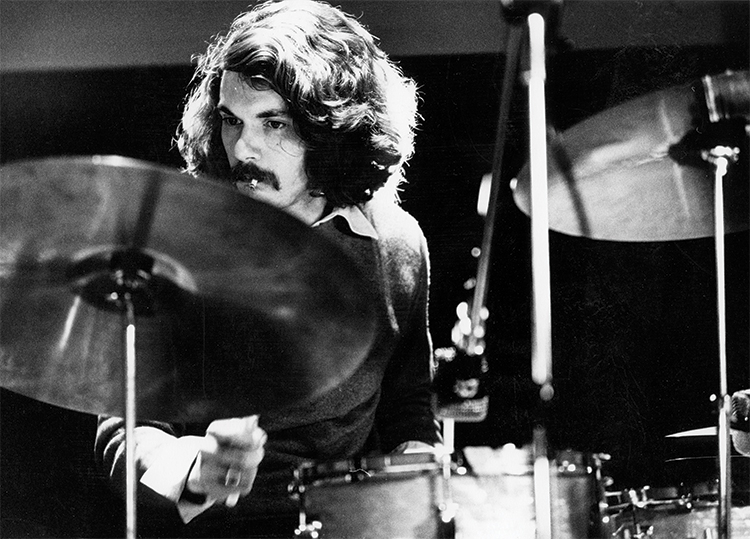 Michael Giles
Michael Giles
When the mind-wrenching riff of “21st Century Schizoid Man” ripped forth from In The Court Of The Crimson King, Michael Giles’ jazz-rich, chops-laden playing not only expanded the parameters of rock drumming, it was proof that creative drumming, whether dispensed with ferocity or delivered in delicate flourishes, would thrive beyond the ’60s. Rush’s Neil Peart took note, seemingly right down to Giles’ moustache.
Ted McKenna of Sensational Alex Harvey Band fame was 19 when Crimson hit. “Giles’ playing in ‘21st Century Schizoid Man’ was groundbreaking. I’d never heard anyone use jazz interpretation in what was, I suppose, the beginning of prog.”
In The Court Of The Crimson King met with meteoric success. A December trek touring it in America was, however, far from deluxe. Giles quit, feeling things had spun out of control. McDonald also quit, and then, lured by Keith Emerson to form ELP, Lake departed.
Within months, however, Lake and Giles were among others recording the band’s sophomore album, though this time as session men. (Apparently Lake’s fee was Crimson’s PA system.) The resultant In The Wake Of Poseidon was a critical and commercial success. But Giles resisted any temptation to rejoin, instead recording a one-off album, McDonald & Giles, with his former bandmate and pursuing a session career. Steve Winwood and Leo Sayer are on his list of credits, while projects, including albums with bassist John G. Perry and one of his own, Progress, satisfied his creative side. Recorded in 1978, Progress was thoroughly revamped before its release in 1992. The title track alone is worth the price of entry.
In 2002, Giles and various other Crimson alumni cofounded 21st Century Schizoid Band. However, after a tour of Japan (where the DVD Live In Japan was recorded), he passed that gig over to another early Crimson member, Ian Wallace.
Giles’ latest venture, the MAD Band, with “drums and percussion, found sounds and guitar and treatments” plus guests including pianist Keith Tippet, sees him in a more experimental mode reminiscent of the outer extremities of early Crimson ventures. Remember, that was his band, too.
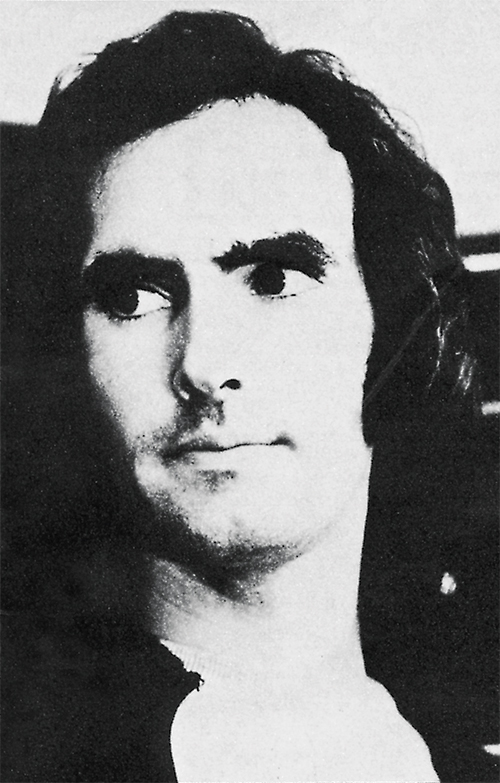 Andrew McCulloch
Andrew McCulloch
Crimson’s next drummer was recommended by Lake. Despite his double bass drums, wicked technique, and deep jazz aesthetic suggesting a perfect fit, McCulloch did only a fleeting stint. He had joined a band that was struggling to emerge from dereliction. How did that go? Well, the resultant album, Lizard, was, to the chagrin of most, disappointing. “Overall,” Fripp told Ultimate Classic Rock, “the album is unlistenable.” Newly recruited bassist/vocalist Gordon Haskell noted that the guitarist was exerting pressure on the players. “Andy McCulloch was in tears. Fripp used to bully him unmercifully. He bullied us all.” Still, McCulloch’s drumming is top notch. On “Cirkus,” he intermingles crisp single stroke snare rolls and melodic tom passages, while on “Glass Tears” he rolls rhythmically around the kit. Why isn’t McCulloch’s name up there with those who defined prog as a drummer’s delight? Possibly it might be had he stayed longer.
Within months, McCulloch split for Greenslade, where alongside former Colosseum organist Dave Greenslade he played exquisitely on albums including Beside Manners Are Extra and Spyglass Guest before the demise of that band in early 1976 saw him abandoning music to become a yachtsman in the Mediterranean.
 Ian Wallace
Ian Wallace
Unlike Giles and McCulloch, Ian Wallace eschewed the double bass and multi-tom setup in favor of a 5-piece kit painted with pastoral imagery. Like his contemporaries, he combined jazz chops, R&B grooves, and rock power to great effect in a lineup that included future Bad Company bassist Boz Burrell and future Camel saxophonist Mel Collins. In his early days, Wallace was in a band with future Yes singer Jon Anderson; then, in late ’68, Wallace did a one-off Yes gig.
Islands and Earthbound, the latter a live album recorded on cassette — ouch! — featured Wallace. While the former had its moments, Earthbound was described by Crimson-affiliated media agency DGM as “brutish and crude,” with the track “Groon” featuring “Wallace’s ferocious drum solo which twists and turns like an injured animal.” A dismayed Fripp failed in his effort to have the album deleted.
But Earthbound was the least of the bandleader’s problems. Alienated by his authoritarian approach, Wallace, Burrell, and Collins quit to form Snape with Alexis Korner, Charlie Watts’ former boss. Though that was a go-nowhere venture, the drummer soon became the darling of the session scene, recording and/or touring with such British stalwarts as Alvin Lee, Steve Marriott, and Ronnie Wood, while in America he toured with Bob Dylan and appears on the bard’s Street Legal album, and is on David Lindley’s El Rayo-X, Stevie Nicks’ Wild Heart, and Don Henley’s I Can’t Stand Still and Henley’s hit “Not Enough Love In The World.” Even the Travelling Wilburys enlisted Wallace’s no-nonsense groove skills. Tragically, Ian Wallace passed away due to illness in 2007.
 Jamie Muir
Jamie Muir
Fripp’s next Crimson lineup included the enigmatic Scotsman Jamie Muir on drums and percussion. A former Edinburgh College Of Art student (from which he was expelled), Muir was inspired by jazzers Tony Williams, Pharoah Sanders, and Kenny Clarke, and his real passion was improvisation. An invite from choreographer Lindsay Kemp (who taught David Bowie and Kate Bush about improv acting and dance) had brought Muir to London. There, Muir teamed up with avant-garde guitarist Derek Bailey, and then with Gilgamesh and National Health keyboardist Alan Gown before Fripp lured him into King Crimson, where he was soon joined by Bill Bruford. Though only onboard for a matter of months, Muir, who would shake, rattle, and bang on everything from bags of dead leaves to chains and gongs, was a catalyst who influenced the band and opened up new areas for Bruford. Indeed, his wild visual presence on live dates and crafty percussing on Larks’ Tongues In Aspic are high points in the Crimson legacy.
So what happened to that madcap percussionist? He quit the band in 1972, returning to Scotland to become an ordained Buddhist monk. In 1980, he dipped back into music and recorded the percussion-oriented Ghost Dance movie soundtrack with Michael Giles before bowing out to become Jamie Muir — painter.
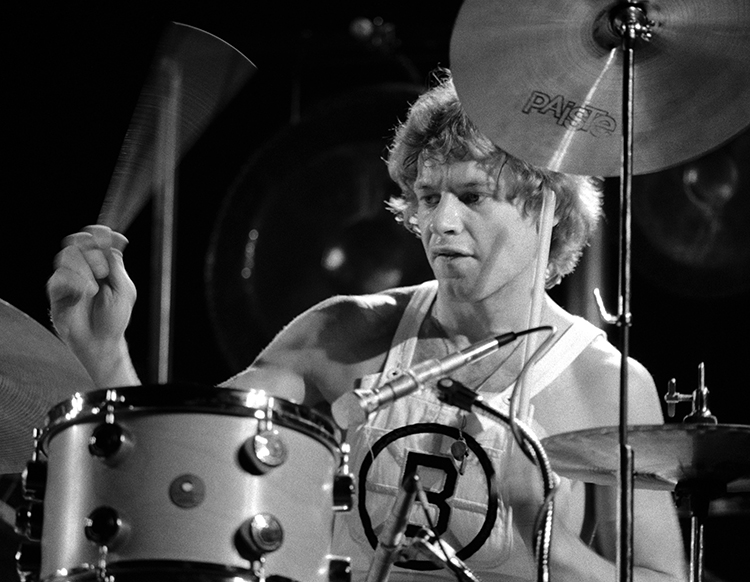 Bill Bruford
Bill Bruford
If it weren’t for an unreliable drunkard taking his place when he first left Yes in the band’s earliest days to attend Leeds University, Bill Bruford might never have ended up in King Crimson. Upon seeing his former band suffering due to their disastrous new drummer — and with an opening slot for Cream’s farewell gig at the Royal Albert Hall looming — Bruford abandoned Leeds in favor of returning to London, and getting to play on the same stage as Ginger Baker, one of his favorites.
A jazzer with an appreciation for the classical aesthetic, but also able to lay down a commanding rock groove and dance through odd times with fluency and finesse (as well as flex with Fripp’s whims), the ever-so-British drummer released his first album with Crimson: Larks’ Tongues In Aspic. Two more, Starless And Bible Black and Red consolidated his place — along with the crack of that snare — in Crimson history.
To join Fripp’s third expedition, Bruford had abandoned superstardom by quitting Yes. With the headline “Yes Man Joins King Crimson” consuming the front page of the July 22, 1972 Melody Maker, the vibe was positive, though not for long. By the time of Red, the lineup had not only dwindled from five down to three — Fripp, Bruford, and bassist/vocalist John Wetton; it was imploding. The music, at times slabs of tortuously grating guitar and angular stabs of rhythm, was increasingly heavier and ominous. Fripp didn’t like it. “It was a quite superb band,” he told Melody Maker, “but what we were doing wasn’t really for me.” He had already told the NME that Crimson was “over for ever and ever.”
Wetton noted in Mountains Come Out Of The Sky that Fripp took the back seat on Red. “He wasn’t sure where this was going. Bill Bruford and myself knew exactly where it was going … and pushed for that very up-front … in-your-face guitar. We did that. It was balls-to-the-wall progressive rock … it was heavy metal, really.” Bruford also came up with the demonic bass riff for “Starless.”
Despite Fripp’s disdain, Nirvana’s Kurt Cobain considered Red a landmark album. And in retrospect it was. And still is.
Joe Bergamini, author of Taking Center Stage with Neil Peart, and whose time with proggers Happy The Man and 4Front saw him pursing odd times with fervor, recalled the Lark’s Tongues In Aspic lineup with Bruford and Muir. “With its free and industrial influences, the music from that period still sounds cutting edge. Bill Bruford’s body of work is unique and intelligent, and Larks’ Tongues, Starless And Bible Black, and Red certainly display this.”
Bruford’s next moves — in addition to various incarnations of Yes — included teaming up with new band National Health; touring with Genesis (he’s on Seconds Out); work with Gong and Led Zep’s buddy Roy Harper; recording his debut solo album Feels Good To Me; being in, then out of super group UK (Terry Bozzio filled his slot); and assembling the band Bruford with guitarist Allen Holdsworth, bassist Jeff Berlin, and National Health keyboardist Dave Stuart, and releasing One Of A Kind, Gradually Going Tornado, and The Bruford Tapes. To see the band, try the Rock Goes To College DVD, wherein Bruford plays machinegun-like single strokes on his combination of acoustic kit and Roto Toms.
In 1982, a change of heart saw Fripp reinvent King Crimson. With Tony Levin on bass and Chapman Stick, and Adrian Belew on voice, guitar, and sonic antics, Bruford and the band recorded another album trilogy: Discipline, Beat, and Three Of A Perfect Pair. By now his kit was augmented with a gong bass drum, Octobans, and Simmons electronics, the latter on which he relayed the single strokes intro to Beat’s “Dig Me,” a reminder that the intelligent application of simplicity can be more powerful than the confusion often created by complexity. Inspired by Belew’s writing and arpeggiated picking (which Belew said Fripp readily embraced) as well as the jungle-like rhythmic grooves of Talking Heads (Belew’s previous band), Bruford increasingly shifted away from cymbals and beats to drums and rhythms, as heard in “Elephant Talk.” McKenna met Bruford while playing with Michael Schenker’s band MSG. “I spoke to Bill. He was a really nice chap as well as an outstanding drummer. Three Of A Perfect Pair is still one of my favorite albums.”
Though the lineup with Belew introduced King Crimson to a broader audience, once again Fripp shut the band down. Never at a loss, Bruford formed Earthworks, with the mission of exposing obscure British talent as well as flirting with the concept of morphing traditional and modern jazz sensibilities. A full Simmons kit reinforced the latter. A later Earthworks incarnation would be fully acoustic. As would be his 1999 album with Ralph Towner and Eddie Gomez.
Bruford would again join Crimson in 1994, this time alongside newcomer Pat Mastelotto in a double-trio concept with Fripp and Belew on guitars, and Levin and Trey Gunn handing the low end. Thrak, B’Boom, and Déja Vroom were some of the titles they recorded before Fripp shut that project down in 1997.
Trouser Press described Thrak as “an absolute monster, a cerebral sextet adventure stunning in its precisely controlled rock power.” As always, this new band differed dramatically from what preceded it.
Retired since 2009, Bruford earned a Ph.D. in Music at the University Of Surrey. “A key motivation in my working life as a drummer,” he notes on the university’s website, “was trying to contribute, to suggest ways that we might go about doing things differently. In a way, my Ph.D. continues with that.”
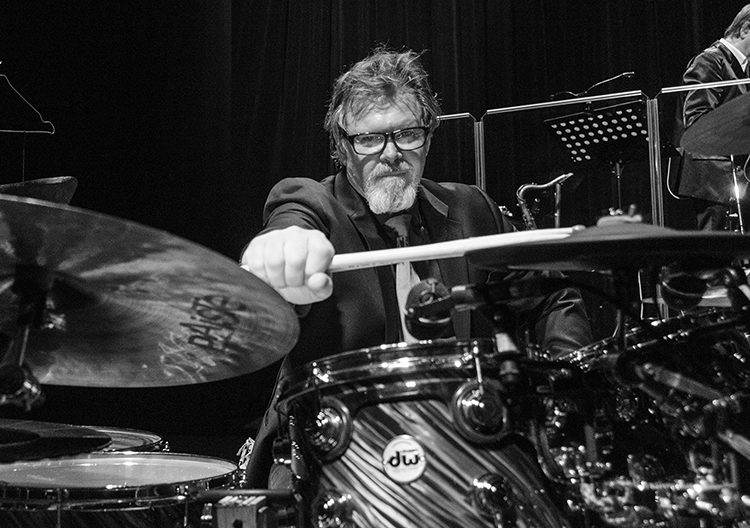 Pat Mastelotto
Pat Mastelotto
Bringing Pat Mastelotto into the Crimson lineup was another surprise move by Fripp. Despite his predilection for jazzy British drummers, the guitarist initially enlisted the relatively unknown Californian for his project with former Japan and Rain Crow Tree art rocker David Sylvian. Mastelotto, who flew to England and auditioned for the gig, had honed his diversity with the likes of Al Jarreau and The Pointer Sisters before joining Mr. Mister, a band defined as much by its excellent musicianship as by its ability to seamlessly blend jazz, rock, world, and pop influences. During that band’s platinum-selling reign, hits including “Broken Wings,” “Kyrie,” and “Is It Love” revealed Mastelotto to be a highly musical player whose skillful ability to combine electronics with his acoustic kit and integrate their sounds into songs in a compositional manner set him well above the standards of the MTV era.
Once Sylvian/Fripp was done, Mastelotto, whose early drum heroes included Michael Giles, found himself alongside Bill Bruford in the 1994 reincarnation of Crimson. At this point, what Mastelotto learned from listening to Jim Gordon, James Gadson, and Jeff Porcaro played a crucial role, as his deeper, more locked-down grooves and rockier feel complemented Bruford’s jazzier and punchier rhythmic approach.
Along the way, the improv band HoBoLeMa saw Mastelotto team up with Holdsworth, Levin, and Bozzio, while various excursions with ConstruKCtion saw Crimson members experimenting in search of new material for their band.
“Mastelotto brought a rock influence to the band,” Bergamini notes. “But he definitely matched Bruford’s complexity and creativity. Experiencing their different sounds and hearing how these two complemented each other is really quite inspiring.”
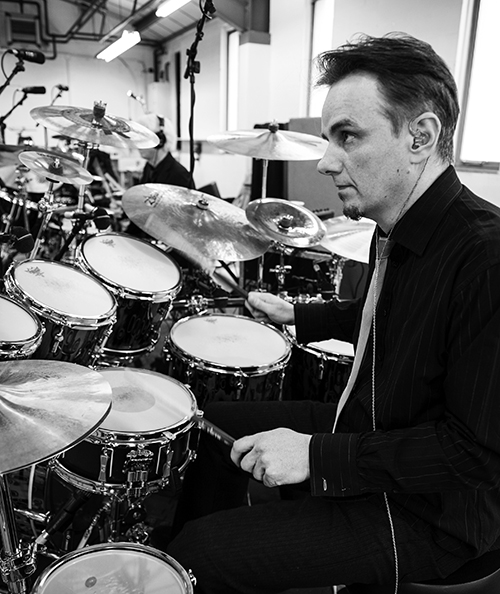 Gavin Harrison
Gavin Harrison
Is Gavin Harrison an ideal example of today’s drummer? It seems so. He’s certainly a perfect fit for Crimson, as his arrival to play alongside Mastelotto in 2007 revealed. The Londoner’s tasty playing in prog renaissance man Steven Wilson’s Porcupine Tree may have been his calling card, but like his American colleague, Harrison had done his share of diverse gigs, from Iggy Pop and Level 42, to Bruford keyboardist Dave Stewart, to David Sylvian’s bass-playing colleague, Mick Karn. A player with expertise in all styles, with his tremendous technical ability and electro-acoustic savvy, it was like he was born to be in this band. Players including Mike Portnoy and Neil Peart, who penned the foreword to Harrison’s book Rhythmic Compositions, told mikedolbear.com in 2006, “I like what Gavin Harrison is doing … His playing and his thinking are interesting, musical, and inspiring.”
And when Late Show With David Letterman was showcasing drummers, Harrison, who played the Jaco Pastorious–inspired “The Chicken,” was included on a guest roster with drummers such as Peart. He also more than held his own alongside Ian Paice, Clem Cattini, Ginger Baker, and Dave Weckl at the 2012 Buddy Rich Memorial Concert in London.
Outside of his main gig, Harrison’s activities with the band 05Ric let him flex the same mental and physical abilities he employs with Crimson. Cleverly creative drum parts, including melodic tom licks and wicked footwork (check “Unsettled”) set to material seemingly inspired by Discipline-era Crimson, is introducing prog to a new generation, much the way Fripp has done over the years, generation after generation, with the king of them all.
And like Bruford, Harrison seeks to help others learn via clinics and a growing list of books and DVDs. His latest CD is Cheating The Polygraph.
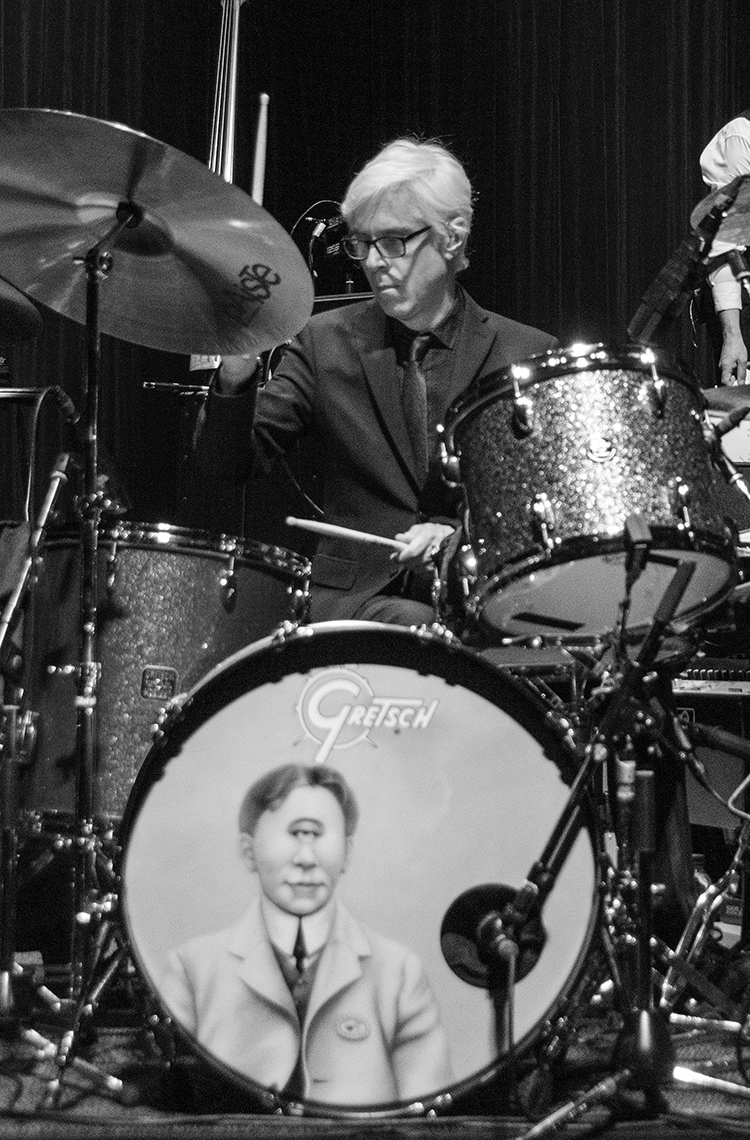 Bill Rieflin
Bill Rieflin
Until the Crimson gig, Seattle-based Rieflin was best known for his time with R.E.M. A multi-talented musician who plays both drums and keys in his new gig, Rieflin is deep into experimental, industrial, and metal, with credits including Nine Inch Nails, Pigface, Ministry, and Swans. Fripp was already familiar with Rieflin, having played on his debut album Birth Of A Giant, and together with him in the improv group Slow Music. Fripp and his missus, Toyah Wilcox, also toured with Rieflin in The Humans, so Fripp knew what he was getting.
Crimson’s three-drummer concept was something Ginger Baker had done back in 1970 with his band Airforce. But from two up to three in Crimson, where every note is strategic and none shall be out of place, well, that seemed to be a bit much. But it wasn’t. Mastelotto has said he, Harrison, and Rieflin figure out all the parts — many of them melody-based unison and interplay — before getting together and doing low-volume test runs. Then they work them up for real on a larger stage before the rest of the band is involved.
However, in early 2016 Rieflin took a sabbatical. In his absence, top London session player Jeremy Stacey was enlisted. Upon his return in 2017 it was announced that Stacey would stay on and Rieflin, according to Fripp in his online diary, “will be focusing on Mellotron, keys, and fairy dusting, rather than using drums as a main instrument.”
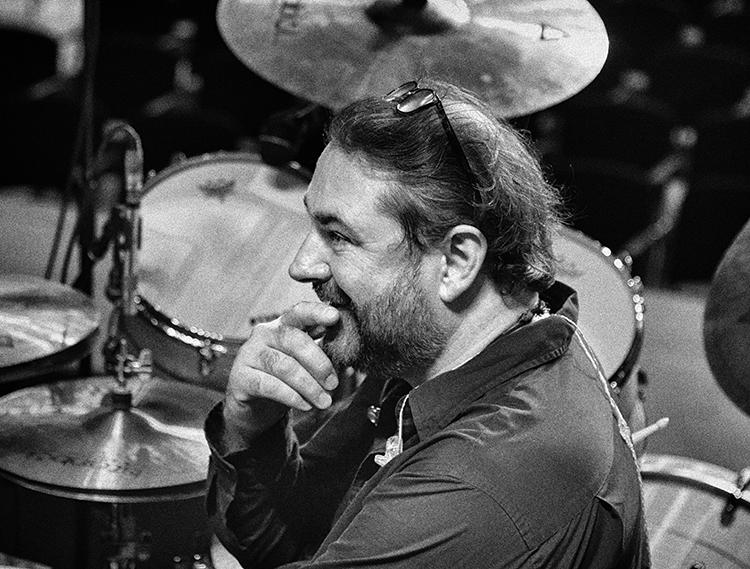 Jeremy Stacey
Jeremy Stacey
“I’m never happy with anything I’ve done,” Jeremy Stacey told Rhythm magazine. But when Harrison recommended him to Fripp, it confirmed that others were impressed by this London-based player-producer, whose credits include Sheryl Crow, Joe Cocker, Noel Gallagher’s High Flying Birds, and Squakett (Yes bassist Chris Squire and guitarist Steve Hackett of Genesis fame). In short, like Harrison and Mastelotto, Stacey had played the gamut and was well equipped to step in for Rieflin.
“When my friend, the amazing Jeremy Stacey, left Noel Gallagher and joined KC,” McKenna says, “I understood, exactly!”
Stacey hit the road with the band in 2016, and in 2017 is touring the world with what is surely the most unique King Crimson thus far. What comes next? Rest assured that the ever-enigmatic Mr. Fripp still has a few surprises to spring on the ever faithful.
Epilogue Or Epitaph?
For nearly five decades, great drummers have energized Robert Fripp’s vision of progressive rock in its most eclectic definition, all the while confirming that the path of progress can be anything but linear.
“I’m amazed at how adventurous and how dangerous the music was, and still is,” Michael Giles told Aymeric Leroy. “I haven’t heard anything like it since.”
McKenna has one word for Crimson drummers: “Adventurers! They’re discovering new avenues of rhythmic expression that can only happen in a band like KC, where a drummer isn’t just the timekeeper but integral to the whole musical landscape.”
“King Crimson,” Fripp noted to Best, “is more a way of doing things. When there is nothing to be done, nothing is done: Crimson disappears. When there is music to be played, Crimson reappears. If all of life were this simple.”
Watch a clip of King Crimson’s legendary performance at Hyde Park, supporting the Rolling Stones in 1969.
Watch Pat Mastelotto, Bill Rieflin, and Gavin Harrison in action with King Crimson performing “The Light of Day” on September 22, 2015, in Paris, France:
